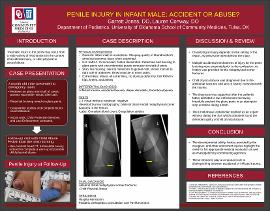| dc.description.abstract | INTRODUCTION: Traumatic injury to the penis may occur from a wide variety of mechanisms in the context of accidental injury, or child physical or sexual abuse. Accidental penile injuries may include injuries occurring during toilet training in a closing toilet lid, with zippers, hair tourniquets, from straddle injuries, kicks, or more traumatic events such as bike wrecks or automobile accidents. Inflicted penile injury may occur in the context of physical or sexual abuse. The developmental ability, history provided by the caregiver, and other concurrent injuries play an important role in distinguishing between accidental or inflicted trauma.
CASE DESCRIPTION: A 3 month old male presented to the emergency room due to redness on the glans and shaft of his penis that parents reportedly noticed after a bath. Coagulation studies and complete blood count were obtained which were unremarkable. Social work, Child Protective Services, and Law Enforcement were contacted. He was seen in follow-up the next morning at the Children’s Advocacy Center, where the Child Abuse Pediatrician ordered imaging studies to complete a work-up of possible child physical abuse, including a non-contrast head CT and a full skeletal survey radiography. Head CT was negative. The skeletal survey found bilateral distal medial metaphyseal corner fractures of the femurs, which raised additional concern for child physical abuse and prompted admission to the Children’s Hospital for further management. Pediatric orthopedics was consulted for management of the fractures; treatment included a Pavlik harness which was managed by orthopedics follow up. The patient’s father later admitted during interviews with law enforcement to have forcefully pinched the glans penis in an attempt to stop urination during the patient’s bath. The Child Abuse Pediatrician testified as an expert witness during the trial for this patient, which ultimately found the defendant guilty of child physical abuse.
DISCUSSION: Classifying an injury as accidental, physical abuse, or sexual abuse depends on the setting in which it is reported as well as the intent behind the injury. Multiple accidental mechanisms of injury for the penis bruising were presented prior to the confession; no history was provided for the metaphyseal corner fractures. Child physical abuse was diagnosed due to the additional fractures and lack of history consistent with the injuries. The diagnosis was additionally ultimately supported by the partial confession. This case represents an uncommon presentation of child physical abuse that highlights the need for full appropriate medical evaluation and investigation by coordinating agencies. | en_US |


